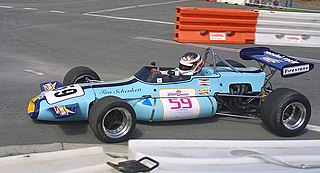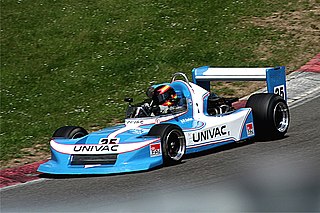
The German automobile manufacturer/brand BMW has been involved in Formula One in a number of capacities since the inauguration of the World Drivers' Championship in 1950. The company entered occasional races in the 1950s and 1960s, before building the BMW M12/13 inline-four turbocharged engine in the 1980s. This engine was the result of a deal between BMW and Brabham, which resulted in the team's chassis being powered by BMW engines from 1982 until 1987, a period in which Nelson Piquet won the 1983 championship driving a Brabham BT52-BMW. BMW also supplied the M12/13 on a customer basis to the ATS, Arrows, Benetton and Ligier teams during this period, with various degrees of success. In 1988, Brabham temporarily withdrew from the sport and BMW withdrew its official backing from the engines, which were still used by the Arrows team under the Megatron badge. Turbocharged engines were banned by the revised Formula One Technical Regulations for 1989, rendering the M12/13 obsolete.

Denis Clive Hulme was a New Zealand racing driver, who competed in Formula One from 1965 to 1974. Nicknamed "The Bear", Hulme won the Formula One World Drivers' Championship in 1967 with Brabham, and won eight Grands Prix across 10 seasons.
The Surtees Racing Organisation was a race team that spent nine seasons as a constructor in Formula One, Formula 2, and Formula 5000.

Formula Two is a type of open-wheel formula racing category first codified in 1948. It was replaced in 1985 by Formula 3000, but revived by the FIA from 2009–2012 in the form of the FIA Formula Two Championship. The name returned again in 2017 when the former GP2 Series became known as the FIA Formula 2 Championship.

Gunnar Axel Arvid Nilsson was a Swedish racing driver, who competed in Formula One from 1976 to 1977. Nilsson won the 1977 Belgian Grand Prix with Lotus.

Jean-Pierre Maurice Georges Beltoise was a French racing driver and motorcycle road racer, who competed in Grand Prix motorcycle racing from 1962 to 1964 and in Formula One from 1966 to 1974. Beltoise won the 1972 Monaco Grand Prix with BRM.

Hubert Hahne was a racing driver from Germany. He was the older brother of Armin Hahne, as well as the uncle of Jörg van Ommen.

Merzario was a Formula One and Formula Two team and constructor from Italy. The team participated in 38 Formula One World Championship Grands Prix but scored no championship points.
March Engineering was a Formula One constructor and manufacturer of customer racing cars from the United Kingdom. Although only moderately successful in Grand Prix competition, March racing cars enjoyed much better success in other categories of competition, including Formula Two, Formula Three, IndyCar and IMSA GTP sportscar racing.
Brian Roger Hart was a British racing driver and engineer with a background in the aviation industry. He is best known as the founder of Brian Hart Limited, a company that developed and built engines for motorsport use.

The Lotus 59 is a racing car built by Lotus Components Ltd. for the 1969 and 1970 seasons of Formula 2, Formula 3, Formula Ford and Formula B.

The Brabham BT36 was an open-wheel Formula 2 race car, designed by Ron Tauranac, and developed and built by British racing team and constructor, Brabham, for the 1971 European Formula Two Championship. Its best result that season was a 2nd-place finish in the championship for Argentine Carlos Reutemann, despite winning only one race, taking one pole position. His consistency and pace made this possible, scoring 6 podium finishes, and finishing the season with 40 points. The Brabham BT36 was constructed out of a complex tubular space frame, and was powered by the naturally-aspirated 1.6 L (98 cu in) Ford-FVA Cosworth four-cylinder engine, which produced 220 hp (160 kW), and drove the rear wheels through a 5-speed Hewland F.T.200 manual transmission.

The March 711 was a Formula One racing car, designed by Robin Herd and Geoff Ferris, for the 1971 season, and saw continued use throughout the 1972 season.

The Brabham BT18 was an open-wheel formula racing car, designed, developed, and built by British constructor Brabham, for both Formula 2 and Formula 3 racing categories. Powered by a Honda engine, it won 11 out of 12 races in 1966.
The Lola T100 is a Formula 2 single-seater entered by German BMW team for the 1967 German Grand Prix, the seventh round of the 1967 Formula One World Championship. Designed by British manufacturer Lola Cars, led by engineer Eric Broadley, the T100 was raced by Britons David Hobbs and Brian Redman. A version adapted to the technical regulations of Formula 1 was also driven by German Hubert Hahne.

The Surtees TS15, and it's derivative, the Surtees TS15A, are open-wheel Formula 2 race car chassis, designed, developed and built by Surtees for the European Formula Two Championship, between 1973 and 1974. German Jochen Mass won two races, and finished runner-up in the 1973 championship, with 42 points. The TS15 was powered by a naturally aspirated, 1.6 L (98 cu in), Ford-Cosworth BDD four-cylinder engine, tuned by Brian Hart, to produce a respectable 200 hp (150 kW). It was the team's final Formula Two car.
The Hart 420R and the Hart 420S are four-stroke, naturally aspirated, 2.0 L (120 cu in), four-cylinder engine, designed, developed and made by Hart Racing Engines, and tuned by Brian Hart, for Formula 2 and sports prototype racing applications, between 1975 and 1980. The 420R is based on the Cosworth FVA, while the 420S is based on the Cosworth BDG, with the design knowledge being taken and used on both. The Hart 420R F2 engine owes much to the Cosworth BDA series, being essentially an aluminium-block derivative using similar heads. Both the 420R and 420S were naturally-aspirated, 2-litre, 16-valve DOHC, fuel-injected, straight-four engines. Displacement is 1,994 cc (121.7 cu in), and maximum power output is between 290–305 hp at 9,500 rpm, with the motor being failsafe to just over 10,000 rpm. The bore is 93.5 mm (3.68 in), and the stroke is 72.6 mm (2.86 in).

The Brabham BT30 was an open-wheel Formula 2 racing car used in the 1969, 1970, and 1971 European Formula Two Championship.

The March 782 was an open-wheel Formula 2 car, designed, developed and built by British manufacturer March Engineering in 1978. The 782 chassis was very competitive, and March dominated the season with their 782 chassis, and it was a clean-sweep; winning 11 out of the 12 races, and Bruno Giacomelli winning the championship, with 78 points. Marc Surer finished second-place in the championship as runner-up, with 48 points ; also driving a 782 chassis. It saw continued used until the end of 1981, with Alberto Colombo winning at Hockenheim in 1980 with a two-year-old 782 chassis.

The March 742 is an open-wheel race car, designed, developed and built by British manufacturer March Engineering, and constructed to Formula Two regulations, and introduced for the 1974 championship. Its Formula Atlantic equivalent, used in the Atlantic Championship, known as the March 74B, was based on the 742.
















